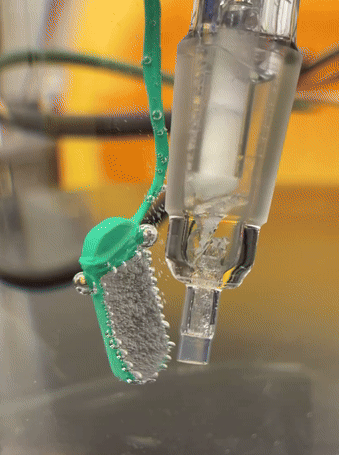Corrosion Resistant Ceramic Infused Metals

Enroute Cal Poly SLO Materials Science Engineering Department
Learn By Doing
I am so thankful for having the opportunity to study MATE in the California Polytechnic State University of San Luis Obispo. The head laboratory technician granted me unrestricted access to expensive on campus resources in exchange for summer assistance. This level of freedom, combined with an outstanding research mission, created the perfect environment to hone my technical field skills.

NitroMax Alloy Rough Cut
| Element Iron Chromium Nickel Carbon Manganese Molybdenum Nitrogen Phosphorus Sulfur |
Weight Percent 65.95 - 40.14 28 - 30 2 - 4 1.7 - 2.2 1 - 2 1 - 1.5 0.35 - 0.38, 0.44 < 0.005 < 0.001 |
Elemental Make Up
Nitromax is a proprietary stainless steel alloy designed for nuclear and ultra high corrosion resistance purposes. It is loaded with chromium carbides and nitrides, while other noble metals impregnate the ferric matrix. Various heat treatments, often blasted then annealed from 1,050 or 1,200 °C, change the prevalence of these impurity islands at the surface. This slightly alters geometric performances. Overall, the ingot is extremely hard and requires specialized diamond blade wafering tools for sizing down to a workable rectangular prism.

Half Micron Orbital Polishing Station | Aluminum + Cerium (IV) Oxide Mirror Finish
Anodes | Cathodes
Turning an irreplaceable sample into a carefully crafted NIST (National Institute of Standards & Technology) grade sample was a task of dexterity. First, a site on the rear face was cleared and a length of chromal wire was spot welded to construct an electrical pathway. Then the exterior of the sample was coated in an insulative polymer cement, except for the test surface. This ensured only the relevant side would affect my data.

Electrode Fabrication Equipment
Liquid Electrolyte
Later, the samples went for a swim, however their pool was not very comfortable. I submerged them in a bath of one molar phosphoric or sulfuric acid. The aqueous ions would provide a bridge for molecular mobility. Of course, the concentrations of these solutions had to be synthesized locally. Most inventoried comercial blends started with an unusual ratio, 20 % weight by weight.

Polyethylene Acid Storage Containers

Ecorr Nitromax Hovers Around -0.35 Volts / KCL, Nominal Stability Value

Active Cathodic Reaction | Fizzing Induces Hydrogen + Oxygen Effervescence
Enable Cell Test
In accordance with the American Society for Testing & Materials, Standard G 5 - 14 (2021), an electrochemical cell was assembled. Reverse linear polarization was conducted with a titanium mesh counter electrode and a saturated potassium chloride reference. Forcing a unidirectional voltage range and demarcating Femto Amperes, 10-15 Amps, yields the equilibrium corrosion potential.

ExtraCurricular Learning
Tribal Knowledge
The excellent training I recieved was truly rare and unique. My advisor was a corrosion specialist for the Yucca Mountain Research Project. The experience transfered from those technical giants strengthened my understanding of the science and reputation amongst my colleagues. I was awarded the marvelous option to instruct my peers in the National Association of Corrosion Engineers on Ionic Mobility Inside Modern Lithium Batteries.